| |
| |
Photographer,
Location |
Images |
Comments |
|

|
Jan
Koeman,
Kloetinge, the Netherlands
Jun. 15, 2007 |
#1,
#2, #3,
#4, more |
After
a thunderstorm at sunset this evening I was suprised by
a beautiful display of mammatus-clouds.
As a bonus one hour later I got my first Noctilucent Cloud-pictures
of this season. Probably the sky was clearly washed after
the heavy rain to display this fine NLC show.
Photo
details: Nikon
D70, set at noise reduction and 200 iso. Exposure time
around 5 seconds with several Nikon lenses from 10,5 mm
fish-eye to 200 mm tele. |
|
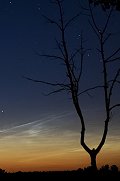
|
Marek Nikodem,
Szubin, Poland
Jun. 16, 2007 |
#1,
#2, #3 |
Photo
details: Nikon
D50, Nikkor 18-70DX, ISO 400, exp. 8-30 sec |
|
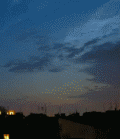
|
Wojciech
Paul,
Krakow, Poland
Jun. 15, 2007 |
#1,
#2 |
Bonus
for staying at work late: noctilucent clouds, after a thunderstorm
Cb leaving north-west (to the right on the photo and film),
with bright Venus over the horizon. It was time enough to
catch fading NLCs on a movie.
Photo
details: Nikon
Coolpix 8400, zoom at 24 mm equivalent, time lapse sequence
every 30 seconds from 21:56 to 22:21 local daylight saving
time. |
|
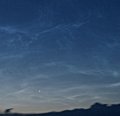
|
Greg Ainsworth,
Bozeman, Montana
Jun. 16, 2007 |
#1 |
Looking
northwest, from 5 miles north of Bozeman. 10:26
PM MDT
Photo
details: Pentax *istDL, 15 sec, f5.6, ISO 200 |
|
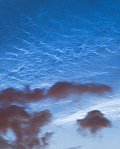
|
Olivier
Vandeginste,
Houwaart, Belgium
Jun. 16, 2007 |
#1,
#2, #3,
#4, more |
Very
nice Noctilucent clouds just after sunset... |
|
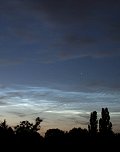
|
Patrick
Bornet,
Saint Martin sur Nohain, Nievre, France latitude: +47oN
Jun. 15, 2007 |
#1,
#2, #3,
#4, more |
first
observation of noctilucent clouds. Sun is 10o
below the horizon (21h UT).
Photo
details: Canon
350D, 10s, 200 ISO. |
|

|
Viktor Veres,
Budapest, Hungary
Jun. 15, 2007 |
#1,
#2, #3,
#4 |
This is was
my first observation of Noctilucent clouds.The show was
very nice,and interesting,I never saw same clouds before
this time...
Photo
details: Canon EOS-1D Mark II N with 17-35 mm lens,
ISO 400, 0.5 sec exposure |
|
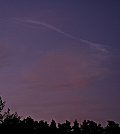
|
P-M
Heden,
Vallentuna, Sweden
Jun. 16, 2007 |
#1,
more |
What
I've learned about NLC is that they can look almost like
anything, the structure and brightness is different from
time to time. Tonight I only saw this NLC filament in the
sky; it showed up and dissapeared in a hour.
Photo
details: Canon
DLSR, 75mm lens |
|
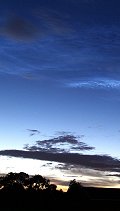
|
Bruno
Nolf,
Otegem, Belgium
Jun. 15, 2007 |
#1,
#2, #3,
#4, more |
After
a turbulent day with violent thunderstorms and showers,
the skies cleared and from past experience I knew that there
might be a chance there would be NLC visible that night.
And surely, at around 23.00h local time, during twilight,
bright, electric bleu tendrils were visible very hight in
the sky, at about 50o altitude. That is very
unusual. I was able to follow the NLC's until they were
at 20o some twenty minutes later and were obscured
by "regular" clouds. Very beautiful!
Photo
details: Olympus E500, ISO 200, Zuiko Digital lens
@14mm (:f28mm in 35mm format)5 second exposures. |
June
15-16, more images: from
Eniko Lelovics of Budapest, Hungary; from
Tibor Horvath of God, Hungary, Europe; from
Monika Gyebnar of Veszprem, Hungary; from
Tomasz Adam of Staszow, Poland; from
Agavriloaiei Ioan of Iasi, Romania, Asociation SARM; |
|